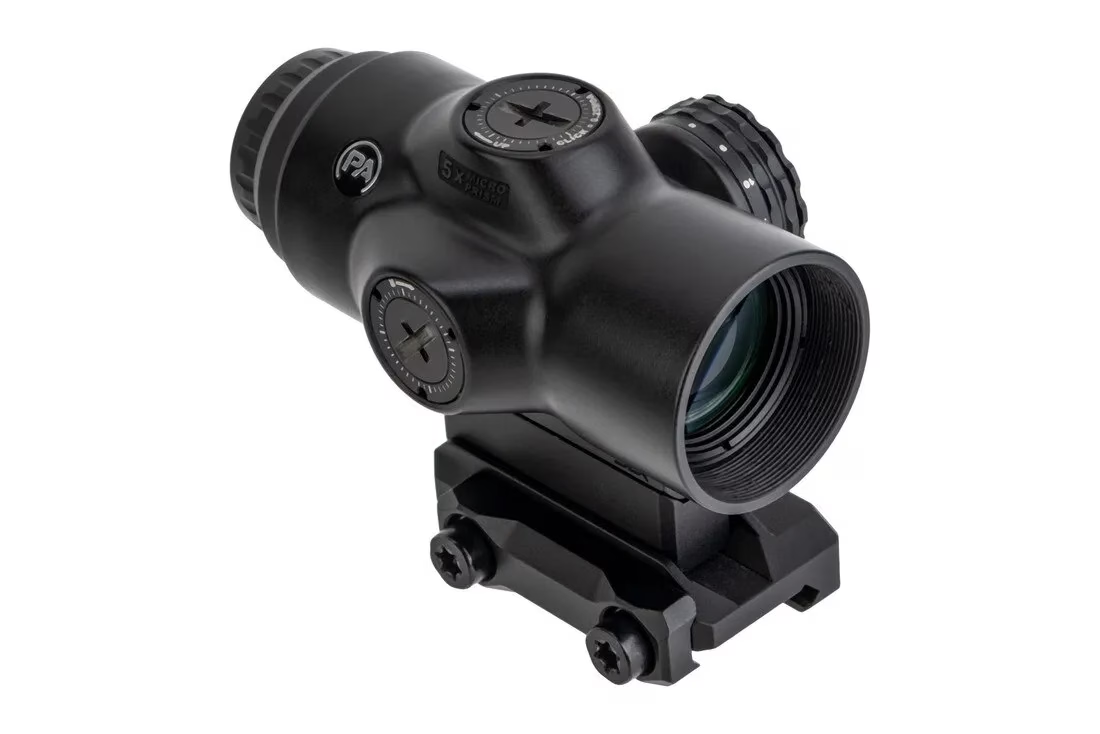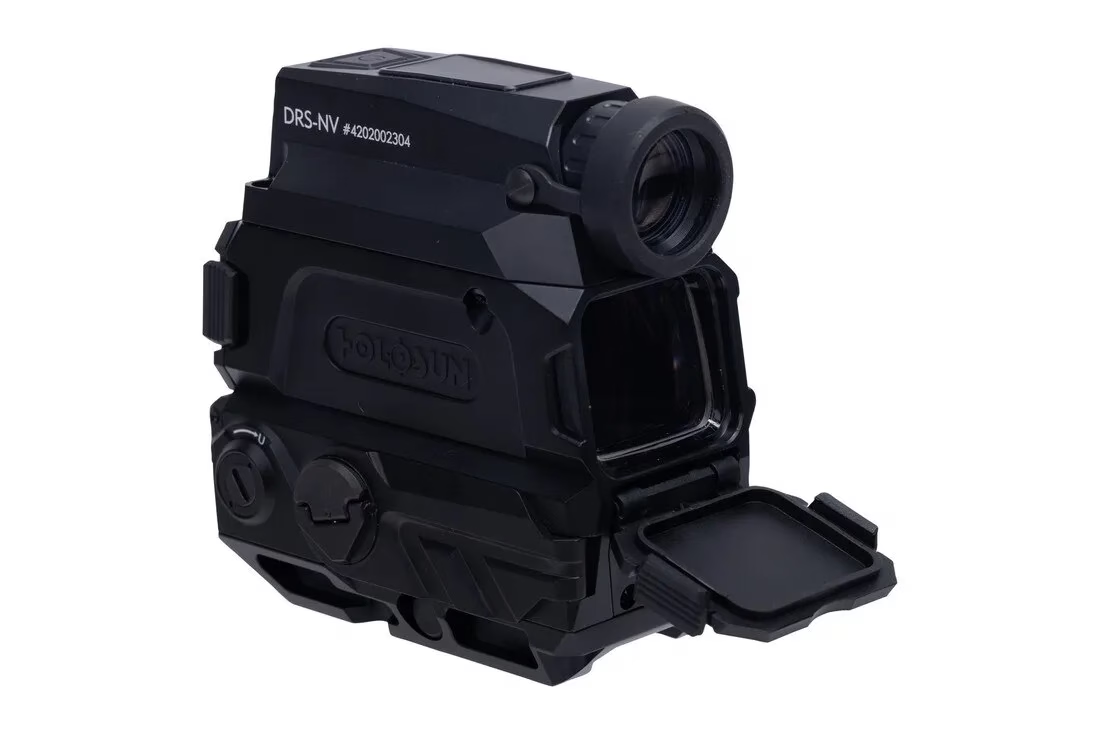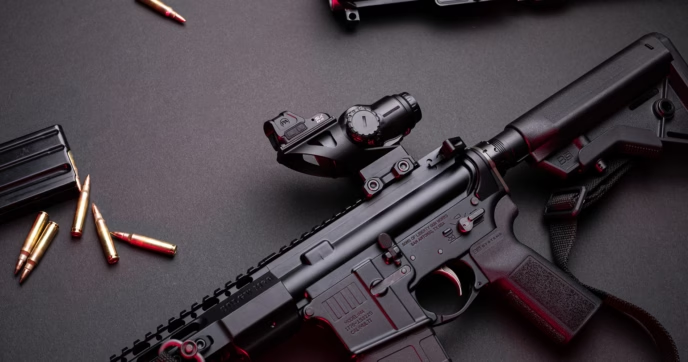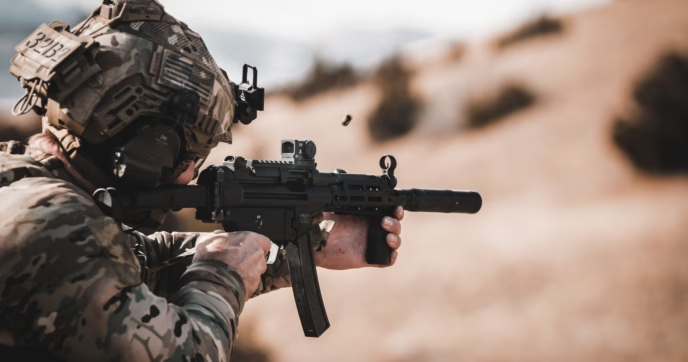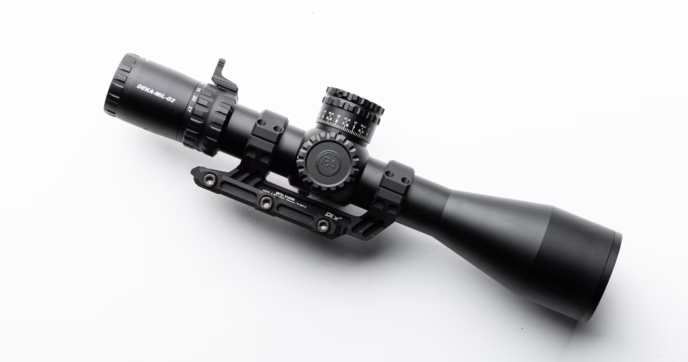In part one of our hunting series, we covered just about everything you need to know when choosing a rifle scope for big game hunting. And while we certainly go over variable power scopes in great detail in that article, one type of rifle scope that wasn’t mentioned was the prism scope.
By design, prism scopes are quite unique, with benefits that land them between reflex sights and traditional rifle scopes. Like reflex sights, prism scopes have a relatively compact footprint and low overall weight, but they are magnified and have etched reticles that are capable of housing more complex designs like traditional rifle scopes.
As such, they excel in several applications, with them particularly well suited for varmint and pest hunting. Outside of big game hunting, pests are some of the most hunted animals in the U.S. And as you’d expect, hunters use different gear to effectively hunt them. For the most part, pest hunters typically opt for semi-auto rifles equipped with prism scopes or reflex sights to do the job, especially when hunting feral hogs and coyotes.
Still, being so unique, there’s a lot to cover when discussing prism scopes. And whenever the topic of hunting pests like coyotes and wild hogs comes about, the topic of night vision isn’t far behind it. So, for part two of our hunting series, we’ll be focusing on the intricacies of prism scopes, their compatibility with night vision devices, and other dedicated night vision sights to consider.

Hunting Pests: Coyotes, Feral Hogs, and other Invasive Species
When most enthusiasts think of hunting land animals, usually the first ones that come to mind are big game like Deer and Elk. However, one of the most common animals hunted across the nation are varmints and pests. The words ‘varmint’ and ‘pest’ are both terms used to describe animals that are either invasive or otherwise viewed as a nuisance. Though varmints tend to be associated with small rodents and mammals like gophers, prairie dogs, and raccoons, pests are understood more broadly with coyotes and feral hogs, two of the most notable pest animals in North America.
Both coyotes and feral hogs are responsible for serious ecological damage. Coyotes, for instance, are predatory animals that, when overpopulated, can heavily diminish large game populations. Even further, in more rural areas, they’re one of the leading causes of livestock deaths. Feral hogs also have a serious impact on local ecosystems. Because of their quick reproduction rates, they’ve become incredibly overpopulated, and they destroy the landscapes they traverse by uprooting native plants, damaging crops, and even harming livestock in some instances.
Because of the damage they cause, these animals are typically hunted year-round, with no specific season. However, we always recommend checking both your state and local laws regarding hunting where you live, as they vary from state to state.
Optimal Rifle and Optics for Pest Hunting
Compared to big game hunting, the gear used for pest hunting is quite different. We go more in-depth on this in our guide on Texas Hog Hunting, but rather than using bolt-actions with high-power variable optics, most enthusiasts typically opt for semi-auto rifles like the AR-15 and AR-10, paired with smaller optics like reflex sights and prism scopes. This combo is highly conducive for pest control, as such rifles and optics are highly effective at engaging multiple targets in quick succession—something that’s highly beneficial since both coyotes and hogs often travel in groups. Plus, both optics typically pair well with night vision devices.
Coyotes are primarily crepuscular, meaning they’re most active at dawn and dusk, while feral hogs, on the other hand, are primarily nocturnal. Although neither one is strictly beholden to these rules, it’s important to recognize that they’re usually most active during times when there’s little natural light outside, which is why many hunters tend to use with night vision devices in conjunction with their prism scopes, or dedicated night vision scopes for hunting pests.
But before diving into the deep end on night vision, it’s critical to understand what exactly prism scopes are, and why they’re so beneficial for pest hunting.
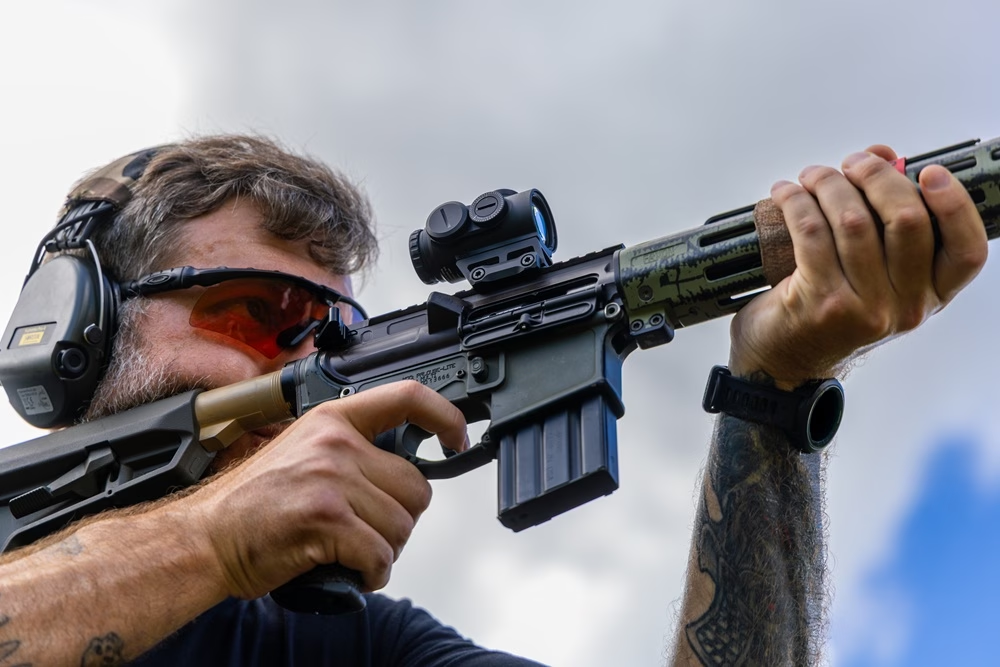
Prism Scopes Explained
Prism scopes have been popular with military and tactical shooters for the better part of a century, but they are also popular in hunting pest animals—especially coyotes and hogs.
Compared to rifle scopes, prism scopes are fairly compact and lightweight, meaning that they’re usually more average than a full powered scope. Like scopes, they have fully etched reticles, though prism scopes are limited to fixed magnification, usually in the 1x to 5x range. For pest hunting, this level of magnification is perfect. If you’re unfamiliar with them, you may be wondering, “why use a prism scope for hunting when I can just use a red dot and a magnifier”? While reflex sights are certainly effective for pests, prism scopes offer a number of advantages compared to them.
Advantages of Prism Scopes
Compared to reflex sights, prism scopes have a few distinct advantages, the most obvious being their etched reticles, added magnification, and overall reliability.
Etched reticles give incredibly precise aiming points with various ranging and targeting data for more difficult shots at distance. While reflex sights can project adaptable reticle systems like Primary Arms Optic’s ACSS® CQB reticle, they’re still only limited to a few elements. With prism scopes, this isn’t an issue. Plus, if you suffer from astigmatism, you’ll have a much clearer point of aim, as prism sights aren’t prone to astigmatic distortions like reflex sights are.
Prism scopes are also offered in an assortment of fixed magnification levels, ranging from 1x models that perform like reflex sights, to 3x, 5x, and even 6x models that perform like magnified rifle scopes. Although having a fixed magnification instead of variable power seems like disadvantage at first, when you compare prism scopes to variable power optics, which are much heavier and bulkier, they offer the magnification you need in in a setup that’s a fraction of the size. It’s also worth mentioning that select 1x prism scopes are compatible with red dot magnifiers, allowing you to easily switch between a magnified and non-magnified sight picture.
Lastly, prism scopes have a reputation for being some of the most reliable optics around. Iconic models like the Trijicon ACOG, for example, are renowned for their battle-proven performance, while other optics designed for civilian applications offer a similar level of performance. Most, if not all, of the industry’s popular prism scope models are designed to be used in just about every environment, so they’re more-than-durable enough to serve as a dedicated hunting optic. Plus, since their reticles are etched, if your optic’s battery was to die, you’d still be able to see the reticle with no issues.
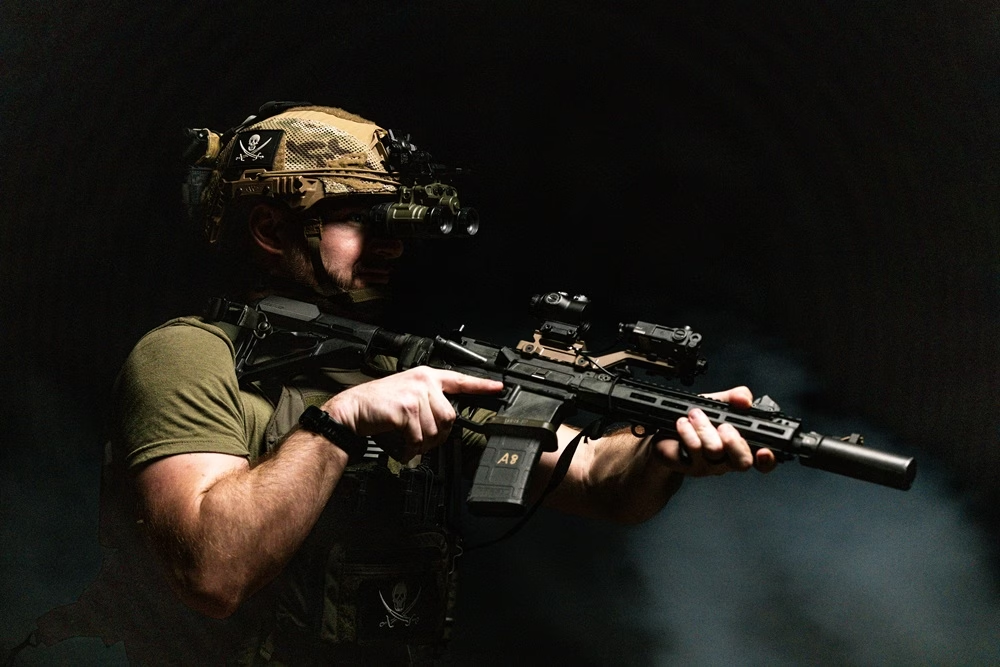
Night Vision Performance
Although reflex sights are generally touted as the go-to optic that’s compatible with night vision goggles, certain 1x prism scopes aren’t too far behind them. As far as passive night vision aiming is concerned, 1x microprism scopes are virtually the same as red dots, and if you prefer using thermals, most prism scopes are compatible with clip-on thermal units as well.
Now, to be fair, there is a lot to talk about when going over night vision, and we cover it in detail in our Ultimate Guide to Night Vision. We will cover the different types of night vision devices used for coyote and hog hunting later, but for a more focused and in-depth look into them, we recommend checking out the article linked above.
Best Prism Scopes
Just like with any other optic variant, choosing a prism scope can be a bit of a challenge, especially since there are so many high-quality options. Below is a list of some of the industry’s popular prism scopes to help get you started in your search.
Primary Arms Optics Prism Scopes
Primary Arms Optics is home to a wide variety of different optics, ranging from reflex sights to variable power optics, and of course, prism scopes. Among the many prism scopes they offer, their MicroPrism series has become one of the industry’s most notable prism scope lines.
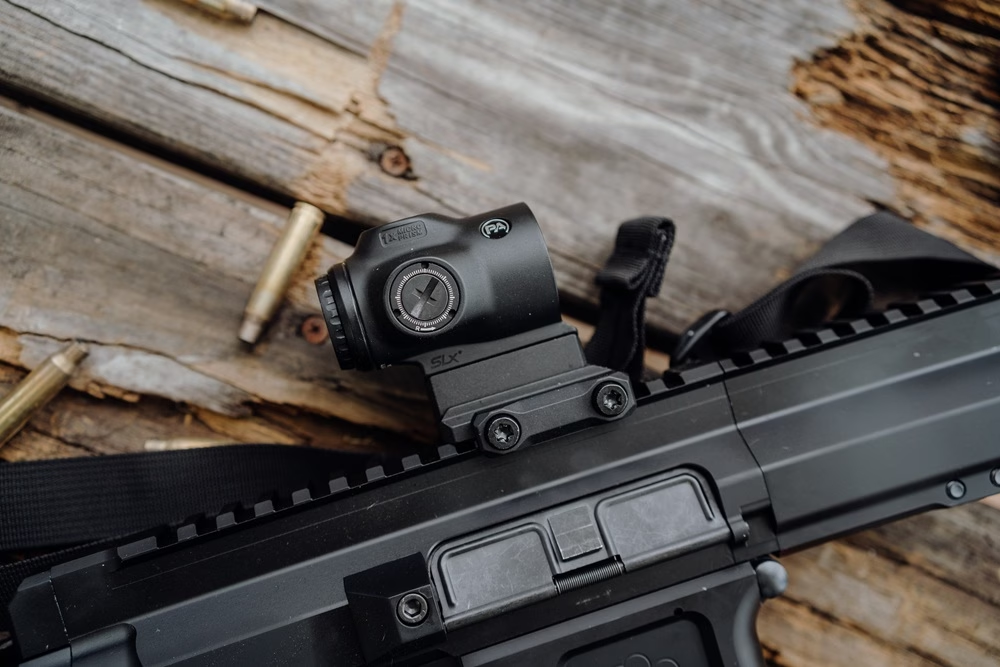
SLx® MicroPrism Scopes
PAO’s SLx MicroPrism scopes are excellent optics that blend utility and affordability. They’re built around an exceptionally durable aluminum housing that’s waterproof, shockproof, and fog resistant, and they’re packed with features that make them highly suitable for hunting. SLx MicroPrisms come standard with multi-coated lenses for optimal light transmission, AutoLive® motion-activation, and 13 illumination settings—3 of which are night vision compatible.
SLx MicroPrism scopes are available in a multitude of magnification levels too, including 1x, 3x, and 5x configurations. SLx 1x MicroPrisms are available with the ACSS® Cyclops® reticle, which is made up of an outer horseshoe for quick target acquisition, an infinitely precise center chevron for fine aiming, and ranging stadia for making holds on targets at further distances. Meanwhile, their 3x and 5x MicroPrism scopes are available with BDC reticles like the ACSS Raptor and Aurora®, as well as MIL-based reticles such as the ACSS Griffin X MIL and ACSS Aurora MIL reticles.
Of the three, SLx 1x MicroPrisms are unique in that they were designed specifically with red dot magnifier use in mind. Unlike magnified prism scopes, the SLx 1x MicroPrism offers a level of performance that’s on-par with reflex sights, as they have a very forgiving eye relief and allow you to use a red dot magnifier with no issues. If you opt for a 3x or 5x MicroPrism, you won’t be able to use a magnifier, but you can opt for PAO’s Piggyback optic mount which will allow you to run an offset mini-reflex sight in the 12-O’Clock position.
Depending on the magnification level and finish, SLx MicroPrism scopes can vary in price, with them generally being priced around $265 to upwards of $400+. Compared to other models though, they’re incredibly budget-friendly, and come equipped with several top-tier features. Plus, they won’t bog down your rifle as the 1x, 3x, and 5x scopes each weigh 5.5, 7.95, and 8.5 ounces, respectively.
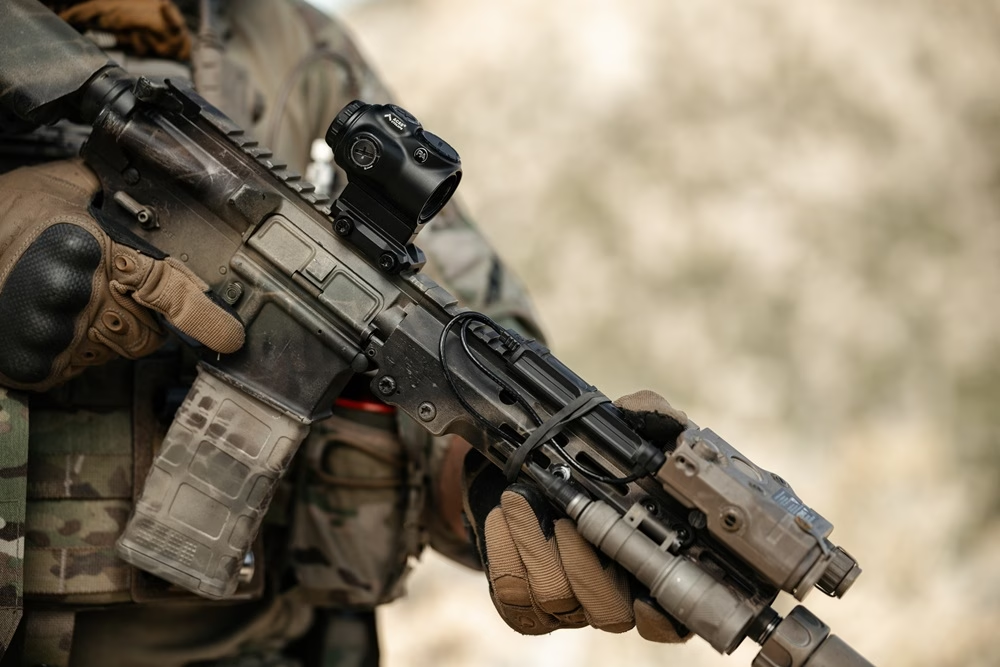
GLx® 1x MicroPrism
If you’re in the market for more of a premium prism scope, you need not look any further than the Primary Arms GLx 1x MicroPrism. Building on the foundation of the SLx 1x Microprism, the GLx 1x MicroPrism is an exceptionally durable optic body that’s built to withstand harsh use in nearly every application. It retains many of the SLx MicroPrism’s key features such as its fully multi-coated lenses, AutoLive motion activation, the same illumination settings, and the venerable ACSS Cyclops reticle. However, it has some key differences that set it apart.
For starters, the GLx MicroPrism uses push button controls instead of a rotary knob for illumination control, and it also houses a larger 20.5-mm objective lens. Because of this, it is slightly heavier than the SLx 1x Prism, but it has a slimmer overall design, and because of its higher quality glass, it offers exceptional clarity and light transmission. Plus, it has near-unlimited eye relief, giving it a level of performance that’s truly on par with red dot sights.
Currently GLx MicroPrism scopes are only available in 1x configuration, but just like the SLx 1x MicroPrism, it’s fully compatible with red dot magnifiers. So, despite only being available in a 1x configuration, the GLx 1x MicroPrism scope is still a solid prism scope for hunting. Being a more premium optic, they are a bit more expensive, but they’re still relatively budget-friendly with them being priced around $320.
Vortex Optics Prism Scopes
Although they’re most well known for their variable power scopes and reflex sights, Vortex Optics has been one of the industry’s most prominent producers of prism scopes for quite some time. While they’re often overshadowed by the many other optics in the Vortex lineup, their Spitfire Prism Scopes remain a solid choice for pest hunting.
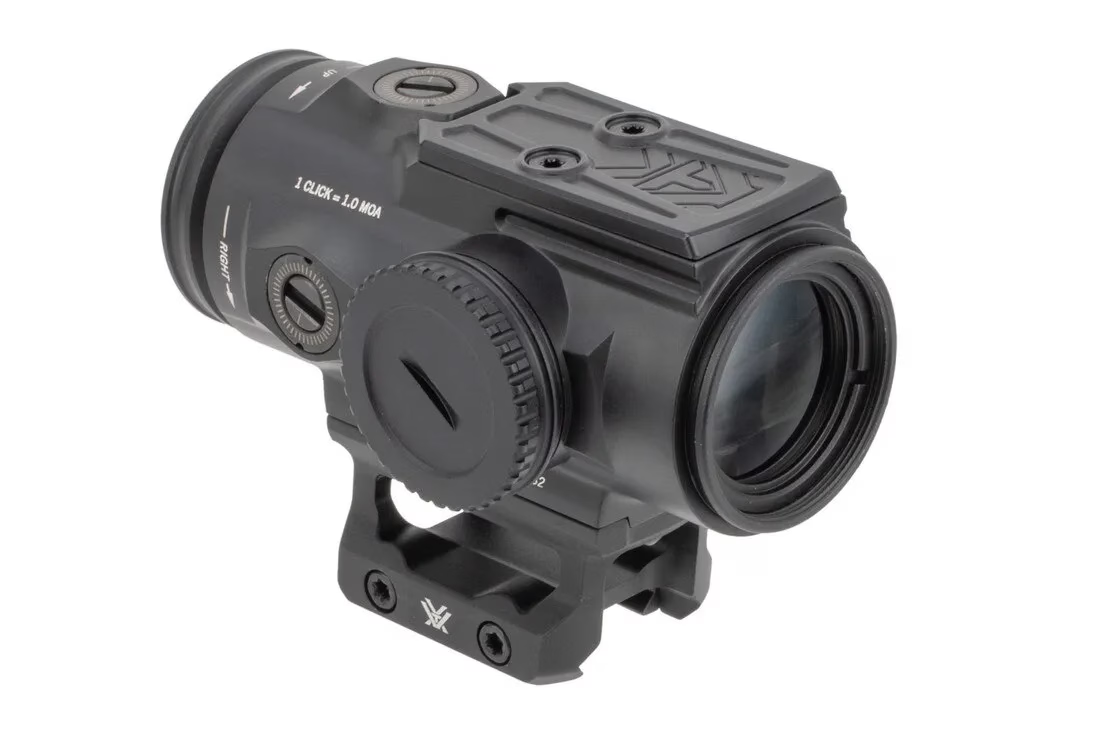
Vortex Spitfire Prism Scopes
Vortex’s Spitfire series prism scopes are currently offered in three configurations, including a 1x, 3x, and 5x model. Construction-wise, they all share similar features, as each one is built around an exceptionally durable aluminum body that’s lightweight and capable of withstanding use in all conditions.
Spitfire optics come standard with fully multi-coated lenses, premium glass, an automatic shut-off that turns the optic off after staying stationary for 14 hours, and 10 brightness settings, two of which are night vision compatible. And to add to their durability and field-readiness, each optic in the Spitfire line is waterproof, shockproof, and fogproof, making them a solid choice for varmint and pest hunting in all environments.
Depending on the magnification level you choose, these optics feature different reticle systems. The 1x Spitfire prism scope makes use of Vortex’s Dual Ring Tactical (DRT) reticle. Unlike conventional circle dot reticle designs, the DRT reticle is comprised of a center dot surrounded by two outer rings, which allow you to quickly acquire your target, and make appropriate holds for both target movement and range/bullet drop. Unlike the PAO SLx and GLx MicroPrism Scopes, the Spitfire 1x prism scope isn’t compatible with magnifiers, making it more of a dedicated close-range optic. It’s still a solid scope, but it’s important to keep this in mind if you’re considering running this optic.
As for the 3x and 5x Spitfire prism scopes, they both make use of Vortex’s AR-BDC4 reticle. This reticle is calibrated specifically for 5.56 NATO, has a segmented outer circle, a center dot for precise aiming, and several MOA-based subtensions that can range out to 650 yards. For varmint and pest hunting, the 3x and 5x models offer a little more utility, and you can still opt for an off-set red dot for close range use too. If you already plan to run an offset dot, the Vortex Spitfire HD Gen II 5x Prism Scope makes it easy, as it has a built-in mini-reflex mount designed for the Vortex Venom/Viper footprint.
Vortex Spitfire scopes can range in price, and they’re also a bit pricier compared to other prism scopes. The 1x Spitfire is typically priced around $350, while the 3x and 5x models usually hover around $580 and $650, respectively.
Night Vision for Pest Control
So, now that you have an idea of what prism scopes are and how they perform, we can move on to night vision. For starters, there are two primary types of night vision optics: NODs and thermal scopes.
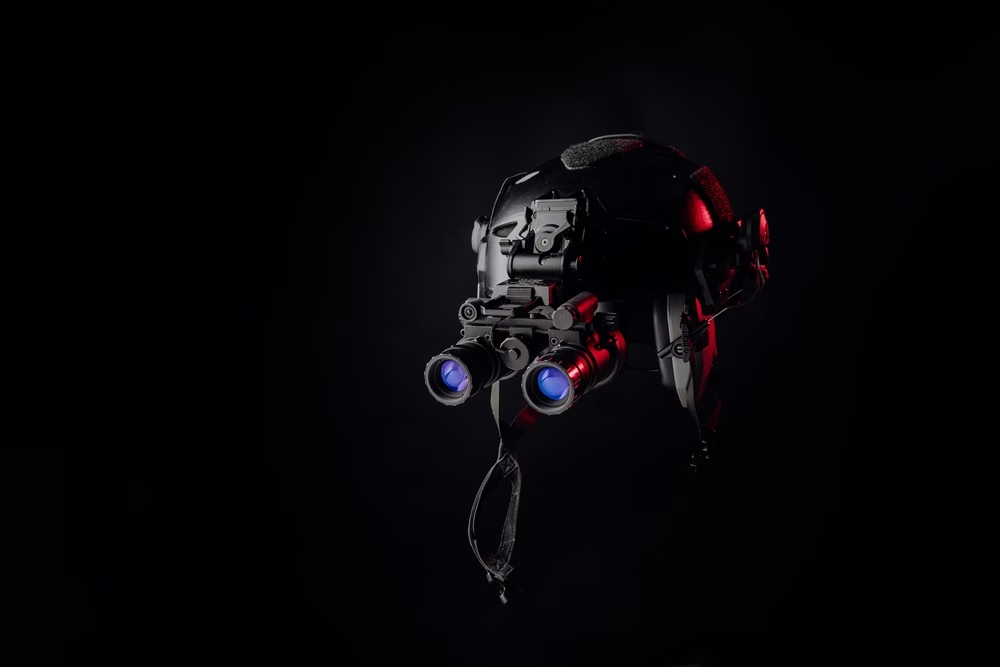
NODs (Night Optical Devices)
NODs are what most enthusiasts typically refer to as “night vision goggles”. They work by picking up ambient light and amplifying it to create a brighter picture of your environment. In lowlight environments, light from the moon, stars, and twilight of the sun are all picked up to give you a better image of your surroundings. Accessories like IR lasers and illuminators can take your capabilities a step further too, allowing you to actively aim with your NODs since the light they project is only visible under NODs.
For nighttime hog and coyote hunting, a good set of NODs is a total gamechanger. As we mentioned above, most prism scopes, like most reflex sights, have night vision compatible brightness settings, which allow for effective passive aiming with NODs. However, it’s important to note that NODs are expensive. Depending on the model you look at, a set of quality NODs can cost anywhere from around $2,000+ dollars to upwards of $15,000+, depending on the model. Plus, you’ll need to also get a bump helmet, or another piece of headgear that’s capable of having NODs mounted to it.
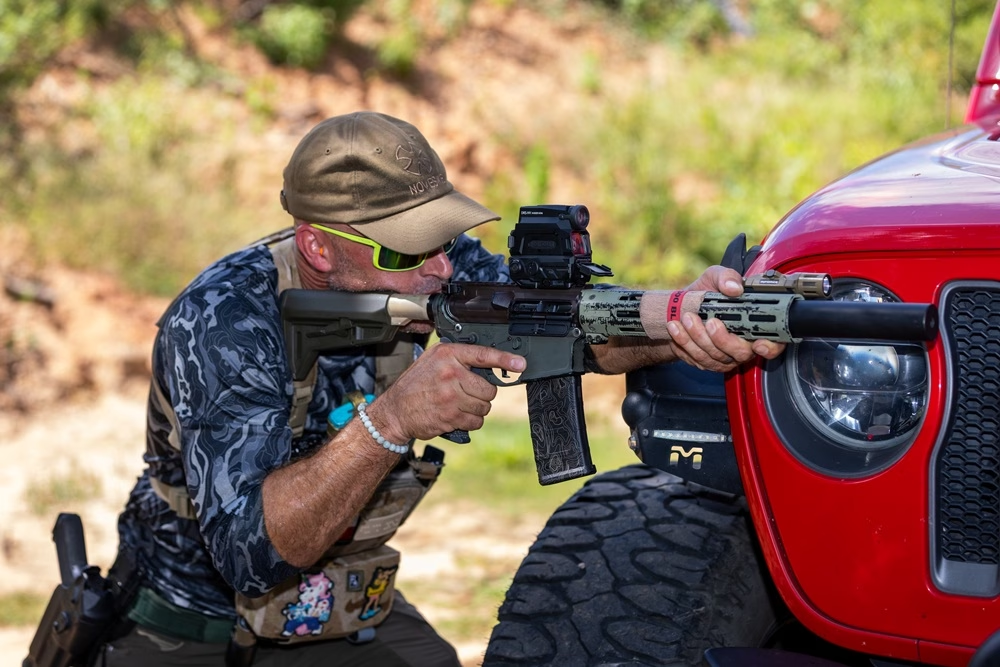
Thermal Imaging
Aside from NODs, thermal units are easily one of the most common forms of night vision tech. Rather than amplifying ambient light, thermal units detect heat signatures—like those put off by animals—and convert them into a digital image. Hotter signatures will appear bright, so they’ll stand out against cooler background objects. And since they detect heat instead of light, you can theoretically use them in pitch black settings. Also, to better fit your personal preferences, most thermal optics can cycle through various color modes, which will illuminate heat signatures in either white, red, or yellow.
Compared to NODs, thermal units are generally much more affordable, with them usually costing around $1,000 to upwards of around $5,000+. Depending on your preference though, you can either opt for a thermal scope or a clip-on thermal unit.
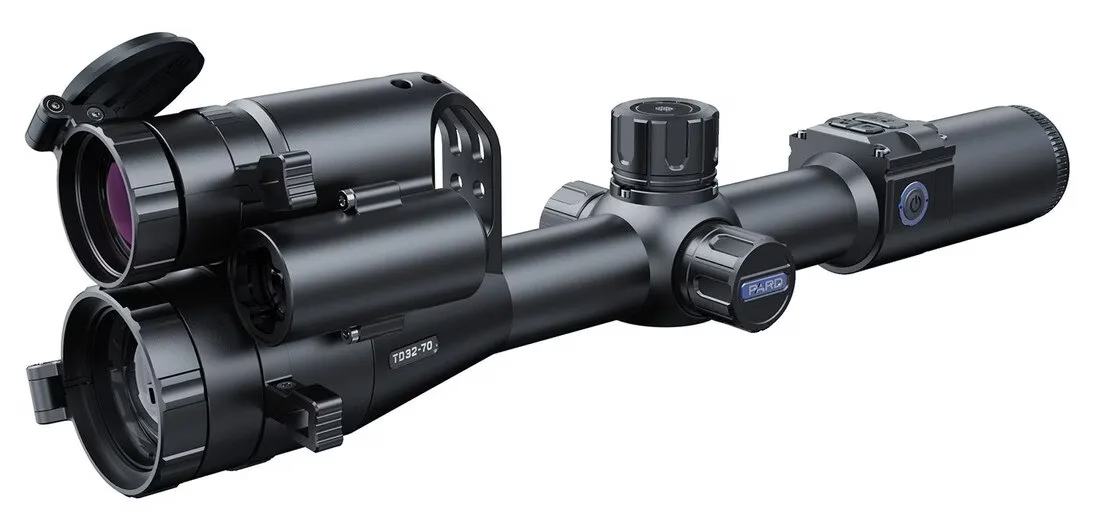
Thermal Scopes
Thermal scopes are essentially rifle scopes that have a built-in thermal imaging system. Depending on the model, they can either have fixed or variable power magnification, and just like a standard rifle scope, they can easily be mounted to your rifle with commonly available scope mounts. Additionally, most of the popular thermal scopes on the market are available with a multitude of reticle and imaging configurations, allowing you to easily tailor your scope to best fit your preference.
By design, thermal scopes are best for those building a dedicated night-hunting rifle as they don’t really offer the most in terms of daytime use, and if you were to remove it to use another optic, you would need to re-zero it before going out to hunt. That said, if you plan to only use your rifle for nighttime hunting, they’re a solid choice.
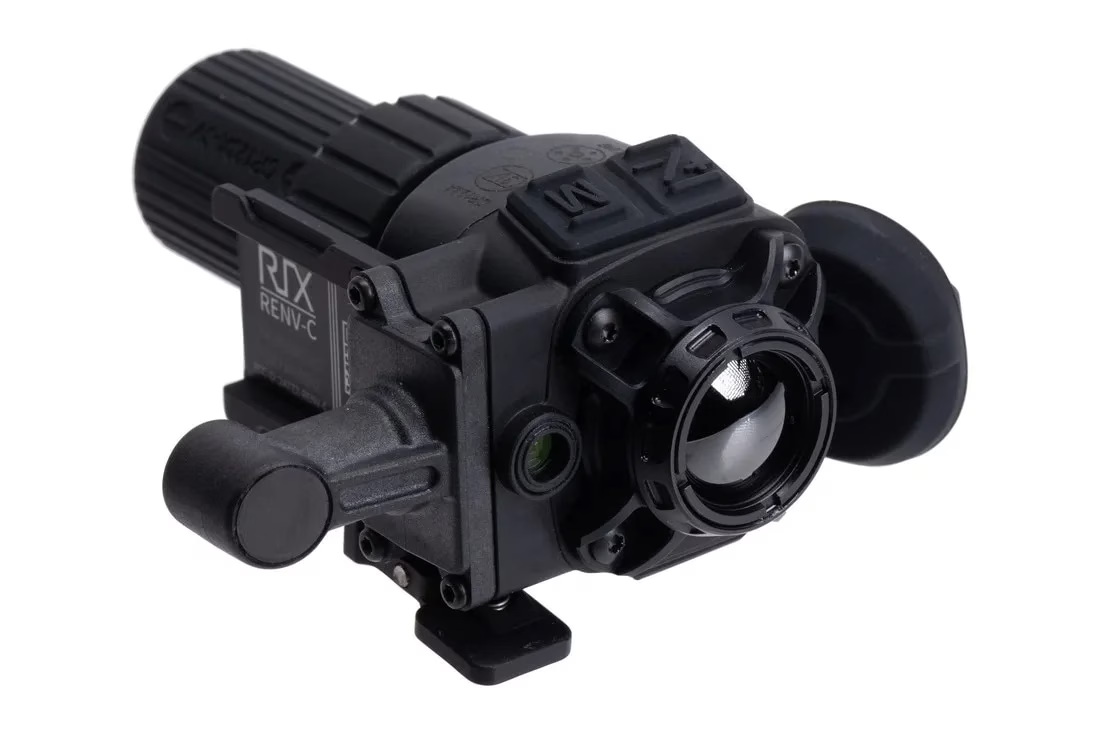
Clip-on Thermal Units
Clip-on thermal units are unique in that they mount in front of other optics to provide a thermal image. So long as you have the rail space on your rifle and the mount heights match, you can realistically use just about any optic with a clip-on thermal unit. Still, they have their limitations to consider as well. For starters, if you aren’t running something like an AR-15 or an AR-10 with a free-floating handguard, you may not have the rail space needed to run a clip-on thermal. Additionally, they can also increase your rifle’s weight by several ounces or even pounds in some instances.
Another crucial consideration is the thermal unit’s image quality. By running a clip-on thermal, you’re essentially using your optic to look through another optic, and as you increase magnification, your overall image quality can take a hit. Granted, this is heavily dependent on the model thermal unit you choose, but increasing magnification can make your sight picture less clear and much grainier.
For prism scopes, this isn’t as much of an issue. Different clip-on thermals have different capabilities, but the maximum usable magnification for most is around 6x to 8x, making them a near-perfect pairing with prism scopes. Still, it’s important to check the manufacturer’s specs to see what each thermal is capable of before buying. It’s also worth noting that you’ll still be able to use your prism scope’s reticle with no issues. Although your prism scope itself isn’t a night vision optic, a clip-on thermal will give you thermal capabilities while retaining your optic’s inherent capabilities. At most, you may need to re-adjust your brightness and diopter to get an optimal sight picture.
Overall, though, clip-on thermal units are a solid choice, as they don’t need to be re-zeroed when removed from your rifle, making them great for those wanting to use their current rifle setups to hunt.
Which Night Vision Device is Best?
There isn’t a single ‘best’ night vision device, as each one has its own unique benefits, and they’re all incredibly versatile for nighttime varmint hunting. So, ultimately, finding the best night vision device is primarily a matter of finding the one that best aligns with your needs and preferences.
If you’re wanting to use a prism scope for hunting, NODs are easily one of the better choices on the table. They’re worth considering for their passive night vision aiming capabilities alone, and when paired with an additional IR illuminator/laser, they offer an incredible degree of versatility. That said, it’s crucial to recognize the NODs are expensive. On the lower end of the cost spectrum, NODs hover around $2,000 to $3,000, and this doesn’t include other gear you’ll need like a bump helmet to mount it too. So, unless you’re really serious about getting into training at night, they aren’t the most budget-friendly choice.
It’s for these reasons that many casual hunters who are looking to get into night vision opt for thermal units. Thermal scopes are considerably more budget-friendly than NODs and are ready to be mounted to your rifle out of the box. And if you want to continue using your prism scope, a clip-on thermal unit that allows you to do so with ease.
Thermal Scope Options
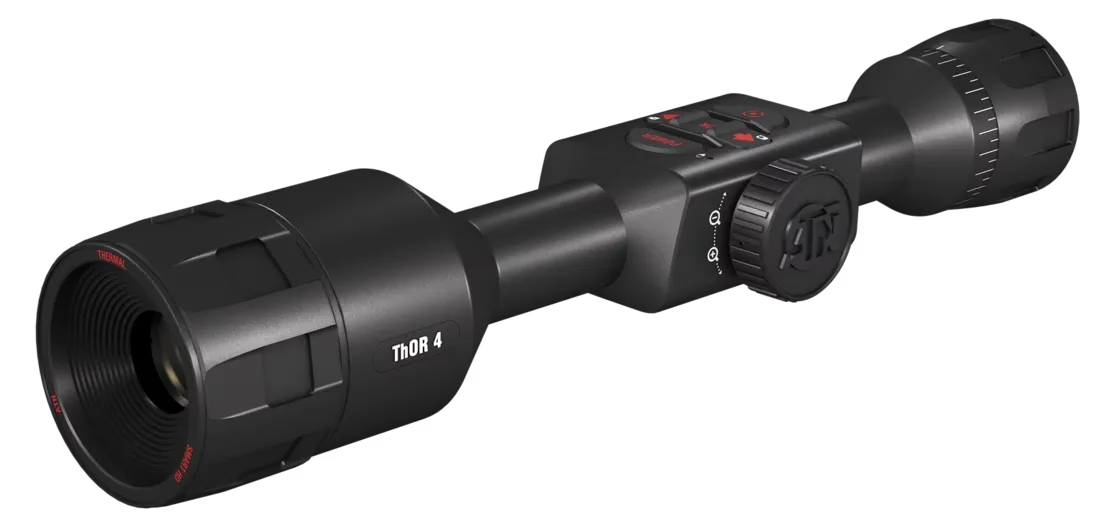
ATN THOR4
ATN Corp. is one of the leading thermal sight brands on the market, known for crafting high-quality optics that can provide you with even higher quality sight pictures at night. The ThOR 4640 1.5-15x Thermal Riflescope is one of their more popular offerings that pairs well with both semi-auto and bolt-action rifles.
The ThOR4 4640 features an impressive 4640×480 thermal sensor that allows you to easily see target heat signatures through fog and even light foliage. Even further, the ThOR 4640 is packed with features such as built-in recording and streaming software, a range finder, a ballistic calculator, and a 3D gyroscope. The ThOR4 4640 is constructed from a highly durable aluminum optic body and is powered by a rechargeable lithium-ion battery, giving it a 16-hour battery life. It even comes standard with its own set of optic rings too.
Lastly, compared to other thermal scopes on the market, the ATN ThOR4 offers an adaptable magnification range of 1.5-15x, making it great for everything from close- to medium-range engagements. Being a thermal optic, it is considerably more expensive than traditional rifle scopes, with it being priced around $2,900. Still, for all its features, it’s still a solid contender if you’re looking for a dedicated nighttime hunting optic.
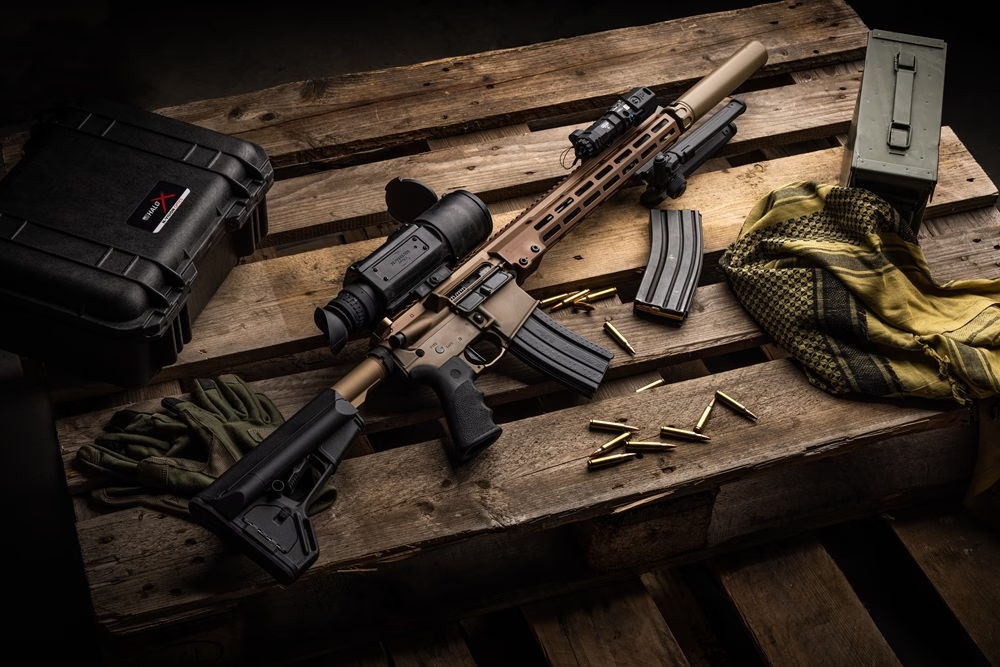
N-Vision Optics HALO-X35
The HALO-X35 35mm Thermal Rifle Scope is another solid thermal hunting optic. Designed for optimal performance in field conditions, the HALO-X35 is built around a durable aluminum housing that’s both waterproof and shockproof, plus, it’s packed to the brim with features that make it more-than-suitable for nighttime pest hunting.
Relying on a digital imaging system, the HALO-X35 is powered by 18650 batteries, giving it 7 hours of constant run time. Unlike the ThOR4, it doesn’t have a traditional magnification adjustment, with it instead having four preset digital magnification settings including a 1x, 2x, 3x, and 8x setting. Essentially, you can view it as a thermal LPVO of sorts. Additionally, this optic has a 640×480 screen resolution with a 60hz refresh rate, giving you a clear and non-laggy image of your target. And lastly, much like the ThOR4 mentioned above, it’s also capable of recording, storing, and streaming videos through Wi-fi.
Compared to other thermal optics, the HALO-X35 is one of the more premium options on the market. As such, you can typically find these thermal optics priced around $6,400. Still, if you’re serious about nighttime pest hunting and want a solid do-all thermal scope, it’s a possibility that’s worth considering.
Conclusion
For varmint hunting, prism scopes are a compelling pick. They offer a unique set of advantages that aren’t found in other optics, and they lend themselves well to a myriad of applications. Still, considering that varmints/pests like coyotes and feral hogs are most active during the low-light hours of the day, night vision is another critical factor to consider. Most if not all prism scopes can be used in tandem with night vision, giving you the ability to use such optics in conjunction with NODs and clip-on thermal units with ease.
Clip-on thermal units allow you to continue running your prism scope while also providing you with solid night vision capabilities. And if you’d prefer to have a dedicated night vision optic, there’s a plethora of thermal scopes to choose from. So long as you’ve taken the time to weigh out the pros and cons of each option before buying, you’ll end up with the best optic set up for your needs, and you’ll have a serious advantage when hunting for varmints.
If you haven’t already checked out Part One of our Hunting Series, we highly recommend giving it a look if you’re in need of a solid big game optic. In Part Three, we’ll take to the skies, covering the best optics for bird hunting. Stay tuned!
